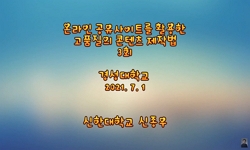Higher Education in Korea have made a rapid progress in a quantitative aspect last 50 years. E-learning, which utilizes information technology actively in teaching and learning, is believed to contribute to the development of higher education. Even th...
http://chineseinput.net/에서 pinyin(병음)방식으로 중국어를 변환할 수 있습니다.
변환된 중국어를 복사하여 사용하시면 됩니다.
- 中文 을 입력하시려면 zhongwen을 입력하시고 space를누르시면됩니다.
- 北京 을 입력하시려면 beijing을 입력하시고 space를 누르시면 됩니다.
https://www.riss.kr/link?id=A75430240
- 저자
- 발행기관
- 학술지명
- 권호사항
-
발행연도
2007
-
작성언어
-
- 주제어
-
KDC
300
-
등재정보
KCI등재
-
자료형태
학술저널
-
수록면
277-307(31쪽)
- 제공처
-
0
상세조회 -
0
다운로드
부가정보
다국어 초록 (Multilingual Abstract)
Higher Education in Korea have made a rapid progress in a quantitative aspect last 50 years. E-learning, which utilizes information technology actively in teaching and learning, is believed to contribute to the development of higher education. Even though e-learning has many merits and strengths, questions and issues on the quality of e-learning has been raised. In order to understand the roles of e-learning and suggest effective development strategies, a more comprehensive study which investigates the e-learning contents status is urgent. This study had two primary purposes, which are germane to the universities in Korea: 1) To identify current status of e-learning contents; 2) to identify implications for further development of e-learning. The population for this study is universities in Korea. Once the web-based survey questionnaire was delivered to all universities, 194 universities replied the survey. The return rate is 96.5%. The major finding of this study are as follows: 1) The ratio of providing e-learning service is 56.7% in universities; 2) the e-learning provision ratio depends on the size of the higher education institute in terms of the number of the students; 3) the number of the e-learning contents has been doubled since 2005; 4) almost 90% of e-learning contents is instructor-centered and most e-learning contents contains video lectures.. Based on the above result, several implications for further development are made. Among them, the followings are important: 1) Establish differentiated strategies according to size, location, and types of universities, 2) assure advanced quality of the contents, 3) enlarge networks among universities, and 4) develop professional organization and staff.
동일학술지(권/호) 다른 논문
-
e-Learning 환경에서 학습자 및 학습과정 특성에 따른 학습전략 차이 분석
- 한국교육정보미디어학회
- 이수경 ( Soo Kyoung Lee )
- 2007
- KCI등재
-
사이버가정학습 우수운영사례 질적 연구: 운영유형별 핵심성공요인 분석을 중심으로
- 한국교육정보미디어학회
- 김도헌 ( Do Hun Kim )
- 2007
- KCI등재
-
- 한국교육정보미디어학회
- 김세리 ( Se Ri Kim )
- 2007
- KCI등재
-
사이버대학 학습자의 성격유형, 자기주도성, 정보기술에 대한 태도 및 자기효능감과 학업성취도 간의 관계 규명
- 한국교육정보미디어학회
- 김소희 ( So Hee Kim )
- 2007
- KCI등재





 KCI
KCI KISS
KISS






